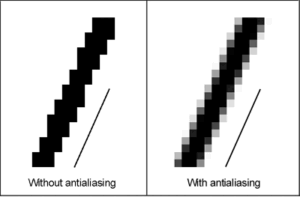Antialiasing, as the name suggests, is a technique used to combat an effect known as aliasing.
When a line is drawn on a piece of paper, its edges appear smooth regardless of the line’s orientation. When a line is drawn on a computer display, whether CRT- or LCD-based, the limited resolution of the display means that, if it isn’t precisely horizontal or vertical, the line will appear as if it is constructed in a series of “steps”. This is aliasing and the stepped effect is often known as “the jaggies”. The various methods used to overcome the jaggies, and produce lines which appear to the viewer to be smooth, are referred to as antialiasing.
The simplest of these techniques is illustrated in the accompanying diagram, in which actual size and enlarged versions of lines drawn on a computer display at an angle of 66°, with and without antialiasing, are shown. The line on the left, without antialiasing, shows the stepped effect of the jaggies. To make the line truly smooth-edged, portions of the white pixels in direct contact with the black pixels would also need to be black but, since only whole pixels can be addressed by displays, another method must be found. Fortunately, the human visual system is fairly easy to fool and the image on the right shows how antialiasing can do this. By using shades which fall between black and white in pixels which form the edge of the line, the stark contrast between the two extreme shades, which humans use to identify edges, is smoothed out and the optical illusion that the jaggedness of the line has been reduced is achieved. Note that the text in the diagram has also been produced with and without antialiasing being applied and how it affects the appearance of the letters.
One of the advantages that CRT displays have over LCD displays is that, because the individual pixels are created by glowing areas of phosphor, they have no definite edges. Consequently, light from adjacent pixels tends to overlap partially, causing slight blurring: a built-in antialiasing effect.
Aliasing can also occur when dealing with digital audio, when it produces the audio equivalent of the jaggies, which is a buzzing sound.

